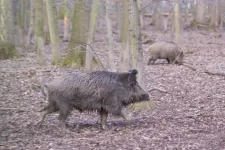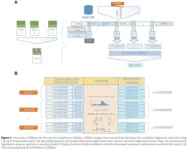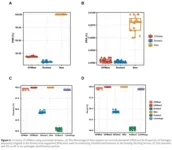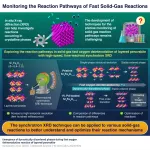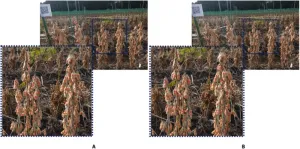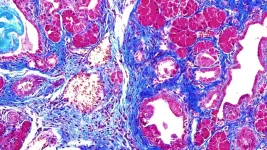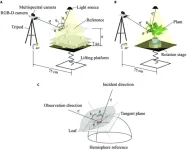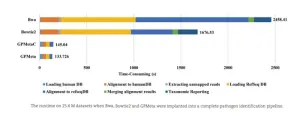(Press-News.org) The researchers focused on 66 PFAS compounds for their study. These can be grouped into three categories: 1) PFAS groups that have been regulated for some time; 2) new PFAS that industry uses as substitutes for regulated PFAS; and 3) precursors that can degrade to other, more persistent PFAS. However, because these individual analyses can detect only a small fraction of the more than 10,000 PFAS used by industry and because many polyfluorinated compounds cannot be measured because of the lack of analytical standards, the research team also determined a sum parameter for PFAS in wild boar using a new advanced method, the TOP (Total Oxidizable Precursors) assay. “The sum parameter indicates the total number of precursor compounds in a sample that can still react to form persistent degradation products”, says Jana Rupp, an environmental chemist at the UFZ and first author of the paper. However, the TOP assay does not provide information on the concentration level of the individual precursor compounds.
The biomonitoring approach, which the UFZ developed together with the German Water Centre in Karlsruhe, was used at three locations in Germany with different conditions: One hot-spot is near the town of Rastatt in the region of Baden, where PFAS-contaminated paper sludge was probably spread on fields as recycled compost until the 2000s. The second hot-spot is an industrial area in southern Germany. The third study site in the north-east of Germany has no anomalies. The background levels of PFAS can thus be determined there.
There are several reasons why the researchers chose wild boar liver. “The wild boar is widespread and hunted everywhere. The species can thus provide a good overview of hot-spots of PFAS distribution in Germany”, says Rupp. Because wild boar are quite mobile and occupy an area of several square kilometres, they reflect the contamination over a larger area. This has an advantage over soil samples with which it is much more difficult to make statements about the PFAS contamination of larger areas. The liver is well suited because it is well supplied with blood: “PFAS do not accumulate in fatty tissue like most environmental pollutants but rather bind to proteins. That’s why they circulate in the blood and are easy to detect in the liver”, says Rupp. Compared with other land-dwelling species such as red deer, roe deer, or chamois, which could theoretically also be considered as indicator species for PFAS, the researchers had found in another study that PFAS concentrations are highest in wild boar liver. This is because the wild boar is omnivorous and at the top of the food chain. It feeds on mice, frogs, snails, or worms, which, in turn, are contaminated. It also burrows a lot in the soil and directly takes up PFAS through this.
The analysis showed that the bioindicator wild boar liver can be used to map PFAS contamination in the habitat of the wild boar. “PFAS are widely distributed – sometimes in large quantities. We were able to detect significantly increased levels in regions with known elevated PFAS contamination”, says Prof. Dr Thorsten Reemtsma, head of the UFZ Department of Analytical Chemistry and last author of the study. For example, the PFAS concentration in the vicinity of the industrial company in southern Germany was almost twice as high as on those areas where PFAS-contaminated paper sludge was used in agriculture – and almost eight-fold higher than the concentrations on the areas with background contamination.
Different distribution patterns of the different PFAS groups at the three sites were also determined via the liver. For example, the industrial site is still dominated by an older PFAS substance that is already banned but which can still be detected because of its extreme persistence. The researchers also found newer PFAS substances that are used by the industry as substitutes for banned PFAS groups. The other two sampling sites contain almost exclusively older PFAS substances. The researchers also found a similar contamination pattern in soil samples from the two hot-spots – much like a chemical fingerprint. “The comparison of PFAS contamination of wild boar and soils proves that wild boar liver is suitable as a bioindicator for PFAS contamination of the terrestrial environment”, says Reemtsma. There is still a great deal of undiscovered local contamination in Germany – also because of the considerable analytical effort involved in using soil samples. “With the liver of wild boars, the contaminated areas can be located and narrowed down in a much more straightforward way”, says Reemtsma.
END
Bioindicator for the occurrence of PFAS
The liver of wild boar indicates the level of PFAS contamination
2023-04-26
ELSE PRESS RELEASES FROM THIS DATE:
Prolonged droughts likely spelled the end for Indus megacities
2023-04-26
New research involving Cambridge University has found evidence — locked into an ancient stalagmite from a cave in the Himalayas — of a series of severe and lengthy droughts which may have upturned the Bronze Age Indus Civilization.
The beginning of this arid period — starting at around 4,200 years ago and lasting for over two centuries — coincides with the reorganization of the metropolis-building Indus Civilization, which spanned present-day Pakistan and India.
The research ...
Advanced X-ray technique unveils fast solid-gas chemical reaction pathways
2023-04-26
For the rational design of new material compounds, it is important to understand the mechanisms underlying their synthesis. Analytical techniques such as nuclear magnetic resonance and spectroscopy are usually employed to study such mechanisms in molecular reactions. However, reaction pathways governing the formation of solid-state crystalline compounds remain poorly understood. This is partly due to the extreme temperatures and inhomogeneous reactions observed in solid-state compounds. Further, the presence of numerous atoms in solid crystalline compounds ...
Paradoxical quantum phenomenon measured for the first time
2023-04-26
Some things are related, others are not. Suppose you randomly select a person from a crowd who is significantly taller than the average. In that case, there is a good chance that they will also weigh more than the average. Statistically, one quantity also contains some information about the other.
Quantum physics allows for even stronger links between different quantities: different particles or parts of an extensive quantum system can "share" a certain amount of information. There are curious theoretical predictions about this: surprisingly, ...
Automated soybean seed counting: Ppgrading existing methods for improved accuracy
2023-04-26
Farming is one of the oldest activities in the world and has always been at the forefront of technological innovation. With mechanized equipment, modified seeds, and digital devices, every aspect of farming, from planting to harvesting is gradually getting optimized. These benefits have also translated to better crop yield estimation for crops such as soybean. Deep learning-based yield estimation models use approaches like regression, traditional bounding boxes, or density maps to make counting of seeds easier. Compared ...
Do fish bay at the moon? Can their odd songs identify Hawaiian mystery fish? Eavesdropping scientists progress in recording, understanding ocean soundscapes
2023-04-26
Using hydrophones to eavesdrop on a reef off the coast of Goa, India, researchers have helped advance a new low-cost way to monitor changes in the world’s murky marine environments.
Reporting their results in the Journal of the Acoustical Society of America (JASA), the scientists recorded the duration and timing of mating and feeding sounds – songs, croaks, trumpets and drums – of 21 of the world’s noise-making ocean species.
With artificial intelligence and other pioneering techniques to discern ...
This killer protein causes pancreatic cancer
2023-04-26
Pancreatic ductal adenocarcinoma (PDAC) is the most common form of pancreatic cancer. It’s also one of the deadliest. More than 90% of PDAC patients die within five years of diagnosis. Usually, by the time the cancer is identified, it has already spread.
“PDAC is often found too late for treatments like chemotherapy and surgery to be very effective,” Cold Spring Harbor Laboratory (CSHL) Professor Adrian Krainer says. “But if we can clearly understand the underlying genetic mechanisms of PDAC, this might lead to earlier diagnoses and new types of therapies.”
Krainer ...
Novel ‘registration’ method identifies plant traits in close-up photos
2023-04-26
Modern cameras and sensors, together with image processing algorithms and artificial intelligence (AI), are ushering in a new era of precision agriculture and plant breeding. In the near future, farmers and scientists will be able to quantify various plant traits by simply pointing special imaging devices at plants. However, some obstacles must be overcome before these visions become a reality. A major issue faced during image-sensing is the difficulty of combining data from the same plant gathered from multiple image sensors, also known as ‘multispectral’ or ‘multimodal’ ...
Introducing GPMeta: Ultrarapid GPU-accelerated pathogen identification approach
2023-04-26
Metagenomic sequencing (mNGS) is a powerful diagnostic tool to detect causative pathogens in clinical microbiological testing. Rapid and accurate classification of metagenomic sequences is a critical procedure for pathogen identification in the dry-lab step of mNGS tests. However, this crucial step may be improved by classifying sequences within a clinically relevant timeframe.
To address this challenge, a BGI Genomics team led by Xuebin Wang has recently launched GPMeta, an ultra-fast pathogen detection approach, and published these highlights ...
Alarming rates of teen suicide continue to increase in the US
2023-04-26
In the United States suicide has become the second leading cause of premature death among those ages 10 to 24; it is the leading cause of death among teens ages 13 to 14.
Researchers from Florida Atlantic University’s Schmidt College of Medicine and collaborators conducted a study exploring trends in rates of suicide among 13 to 14 year olds in the U.S. from 1999 to 2018. They also explored possible modifications by sex, race, level of urbanization, census region, month of the year and day of the week.
Results, published online ahead of print in the journal Annals of Pediatrics and Child Health, showed that among children ages 13 to 14, suicide rates ...
Thinking About an Unconventional Spelling for Your New Product or Service? You May Want to Reconsider
2023-04-26
Researchers from University of Notre Dame and The Ohio State University published a new Journal of Marketing study that examines how the use of unconventional spellings of a brand name impacts consumers’ inferences about and willingness to support the brand.
The study, forthcoming in the Journal of Marketing, is titled “‘Choozing’ the Best Spelling: Consumer Response to Unconventionally Spelled Brand Names” and is authored by John P. Costello, Jesse Walker, and Rebecca Walker Reczek.
Choosing a brand ...
LAST 30 PRESS RELEASES:
Injectable breast ‘implant’ offers alternative to traditional surgeries
Neuroscientists devise formulas to measure multilingualism
New prostate cancer trial seeks to reduce toxicity without sacrificing efficacy
Geometry shapes life
A CRISPR screen reveals many previously unrecognized genes required for brain development and a new neurodevelopmental disorder
Hot flush treatment has anti-breast cancer activity, study finds
Securing AI systems against growing cybersecurity threats
Longest observation of an active solar region
Why nail-biting, procrastination and other self-sabotaging behaviors are rooted in survival instincts
Regional variations in mechanical properties of porcine leptomeninges
Artificial empathy in therapy and healthcare: advancements in interpersonal interaction technologies
Why some brains switch gears more efficiently than others
UVA’s Jundong Li wins ICDM’S 2025 Tao Li Award for data mining, machine learning
UVA’s low-power, high-performance computer power player Mircea Stan earns National Academy of Inventors fellowship
Not playing by the rules: USU researcher explores filamentous algae dynamics in rivers
Do our body clocks influence our risk of dementia?
Anthropologists offer new evidence of bipedalism in long-debated fossil discovery
Safer receipt paper from wood
Dosage-sensitive genes suggest no whole-genome duplications in ancestral angiosperm
First ancient human herpesvirus genomes document their deep history with humans
Why Some Bacteria Survive Antibiotics and How to Stop Them - New study reveals that bacteria can survive antibiotic treatment through two fundamentally different “shutdown modes”
UCLA study links scar healing to dangerous placenta condition
CHANGE-seq-BE finds off-target changes in the genome from base editors
The Journal of Nuclear Medicine Ahead-of-Print Tip Sheet: January 2, 2026
Delayed or absent first dose of measles, mumps, and rubella vaccination
Trends in US preterm birth rates by household income and race and ethnicity
Study identifies potential biomarker linked to progression and brain inflammation in multiple sclerosis
Many mothers in Norway do not show up for postnatal check-ups
Researchers want to find out why quick clay is so unstable
Superradiant spins show teamwork at the quantum scale
[Press-News.org] Bioindicator for the occurrence of PFASThe liver of wild boar indicates the level of PFAS contamination
